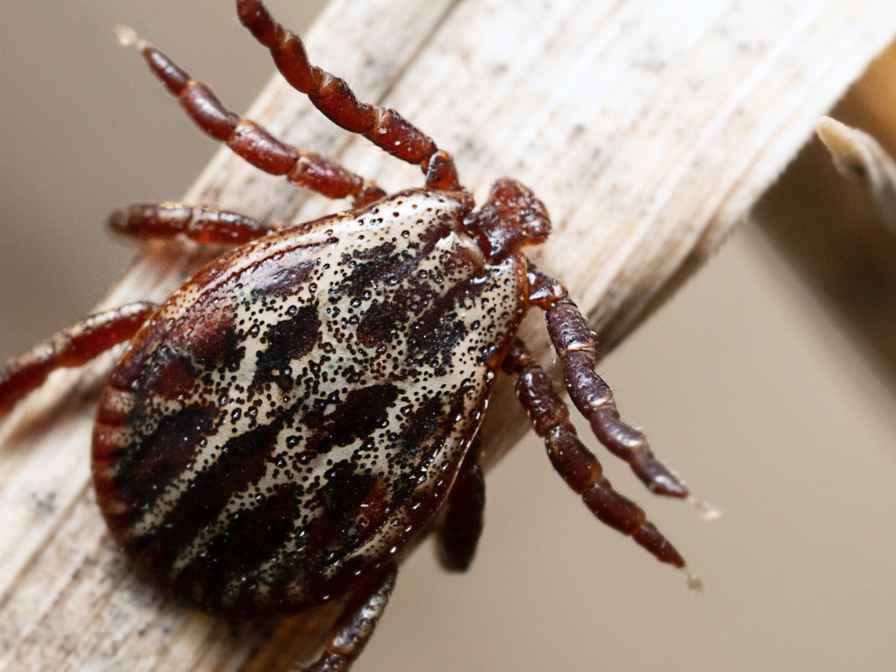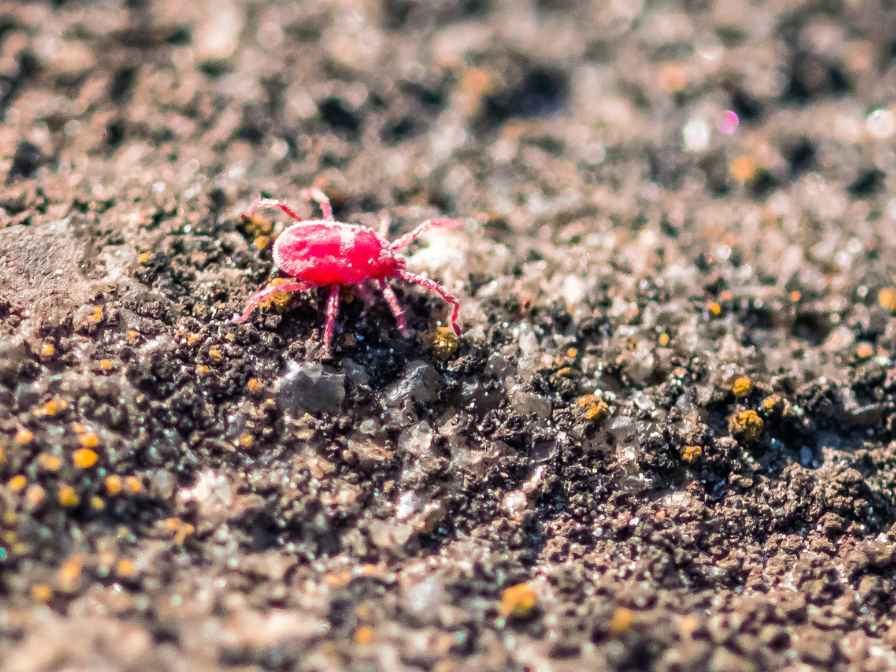Soil mites can be beneficial for plants as they are part of the ecosystem. But sometimes they can cause damage, especially to the indoor plants, where you have invested money, effort, and energy. That’s why we are going to tell you how to get rid of soil mites in indoor plants.

Soil Mites in Indoor Plants
Soil mites are small arthropods that are commonly found in the soil of indoor plants. They are usually harmless and play a beneficial role in the ecosystem of the plant, as they break down organic matter and help recycle nutrients.
Soil mites are typically microscopic in size and are not visible to the naked eye. They are often whitish or translucent in color and have elongated bodies with multiple legs. In indoor plants, soil mites can thrive in the warm and moist environment of potted plants.
They feed on dead plant material, fungi, and other microorganisms in the soil, helping to decompose organic matter and recycle nutrients back into the plant. In small numbers, soil mites are usually not a cause for concern and can even be beneficial for the overall health of the plant.
However, if their population becomes too large, they can potentially cause damage to the plant by consuming live plant roots or becoming a nuisance due to their sheer numbers. Proper care and maintenance of indoor plants, including avoiding overwatering and providing good drainage, can help prevent soil mite infestations and maintain a healthy indoor plant environment.
Disadvantages of Soil Mites in the Indoor Plants
Well, there are disadvantages presence of soil mites in indoor plants. Here are some of these as follows:
Damage to Plant Roots
In some cases, soil mites can consume live plant roots, especially when their population becomes too large. This can lead to root damage, reduced plant growth, and an overall decline in plant health.
Severe infestations of certain types of soil mites, such as root-knot mites, can cause visible galls or swellings on plant roots, which can impede the plant’s ability to take up water and nutrients.
Nuisance and Allergies
Large populations of soil mites in indoor plants can become a nuisance, as they can crawl out of the soil and onto the plant leaves, stems, or even the surrounding areas. This can be unsightly and bothersome for plant owners.
Additionally, some people may be allergic to soil mites, and exposure to them can trigger allergic reactions, such as itching, sneezing, or respiratory issues, in sensitive individuals.
It’s important to note that soil mite infestations in indoor plants are relatively rare and usually occur when the plant is not properly cared for, such as overwatering or providing excessive organic matter in the soil.
Regular monitoring, proper watering practices, and maintaining a healthy indoor plant environment can help prevent or mitigate the potential harm associated with soil mites in indoor plants. If you suspect a soil mite infestation in your indoor plants, it’s best to consult with a plant care professional for proper identification and management strategies.
Things to Consider
Before attempting to get rid of soil mites in indoor plants, there are several important things to consider:
Identification of Soil Mites
It’s crucial to correctly identify the type of soil mites present in your indoor plants. There are many different species of soil mites, and some are beneficial to the plant’s ecosystem as they help break down organic matter and control other pests.
So, it’s important to determine if the soil mites are actually harmful to your plants or if they are just a harmless part of the natural ecosystem.
Plant Species and Health
Different plant species have different tolerance levels for soil mites. Some plants may be more susceptible to damage from soil mites, while others may not be affected at all. Consider the health and maturity of your plants before taking action against soil mites.
Severity of Infestation
The severity of the soil mite infestation should also be taken into consideration. If the infestation is mild and not causing any significant damage to your plants, it may be possible to simply monitor the situation and allow the mites to naturally balance out in the ecosystem.
Environmental Impact
Consider the environmental impact of the methods you plan to use to get rid of soil mites. Some pesticides or insecticides may have negative effects on the environment, including other beneficial insects, animals, and the overall ecosystem. Opt for environmentally-friendly options whenever possible.
Follow-up and Monitoring
It’s important to have a plan for follow-up and monitoring after implementing control measures. Regularly inspect your plants and soil for any signs of re-infestation or new issues. Adjust your control methods accordingly if needed.
Prevention
Prevention is always better than cure. Once you have effectively dealt with the soil mite infestation, take preventive measures to avoid future infestations. This may include maintaining good plant hygiene, avoiding over-watering, using a sterile potting mix, and avoiding bringing infested plants or soil into your indoor garden.
It’s always recommended to consult with a qualified horticulturist or pest management professional for proper identification and control of soil mites in indoor plants, as they can provide tailored advice based on your specific situation.
How to Get Rid of Soil Mites in Indoor Plants

There are many methods to get rid of soil mites in indoor plants. Here are some of the effective ones as follows:
Drying Out the Soil
Soil mites thrive in moist environments, so allowing the soil to dry out can help reduce their population. Avoid overwatering your indoor plants and ensure that the pots have proper drainage to prevent water from accumulating in the soil.
Allow the top inch of the soil to dry out before watering again, as this can help create unfavorable conditions for soil mites.
Removing the Top Layer of Soil
Another method to control soil mites is to carefully remove the top layer of soil from the plant pot. This can help reduce the population of soil mites, especially if the top layer of soil is heavily infested. Be sure to use clean tools to avoid spreading the mites to other areas and dispose of the infested soil properly.
Using Predatory Mites
Some types of predatory mites, such as Hypoaspis miles, are known to feed on soil mites and can be introduced into the potting soil to control their population. These beneficial mites can help naturally reduce soil mite numbers without causing harm to the plant.
Predatory mites can be purchased from gardening supply stores or online and should be used according to the instructions provided.
Go for Neem Oil
To control soil mites, neem oil is an organic insecticide. Mix neem oil with water as per the manufacturer’s instructions and apply it to the top layer of soil in the plant pot. Neem oil works by disrupting the feeding and reproductive ability of mites, helping to reduce their population.
Maintaining Cleanliness
Keeping your indoor plant environment clean and free from debris can help prevent soil mite infestations. Remove any fallen leaves, dead plant material, or organic debris from the surface of the soil, as these can serve as food sources for soil mites. Regularly clean the area around your indoor plants and maintain good overall plant hygiene.
Chemical Alternatives
Hydrogen peroxide mixed with water is a great chemical alternative for getting of soil mites in indoor plants. You just have to add three parts of water and add one part of hydrogen peroxide. It will get rid of mites, as well as their eggs and larvae.
It’s important to note that the use of chemical pesticides should be avoided unless absolutely necessary, as they can harm beneficial organisms and may have negative effects on the environment and human health. Always follow the instructions provided by the manufacturer when using any pest control methods, and if in doubt, consult with a plant care professional for proper guidance.
In short, soil mites in indoor plants can be beneficial but they can also cause problems. You can get rid of these mites by adopting some of the very easy measures. If necessary you can use chemicals or insecticides, but with proper guidance and care.
FAQs
Are soil mites good or bad?
Well, overall soil mites are good for both indoor and outdoor plants. But the problem arises when there is excess. As excess of everything is bad, the excess of soil mites’ can cause infestation or root damage as well.
What is the best insecticide for soil mites?
Well, there are many insecticides that are quite effective. You can use dish soap, neem oil, garlic, or cinnamon mixture as these are organic based. You can use hydrogen peroxide as well to treat soil mites chemically.
What is the role of mites in the soil?
Mainly these are important decomposers in the soil. These soil mites decompose dead roots, recycle nutrients and also decompose organic matter in the soil. excess of soil mites can cause an infestation in the soil.

